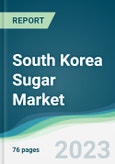Based on industry vertical, the South Korea Sugar market is segmented as food & beverage and pharmaceutical. The food & beverage sector is expected to grow at a significant rate during the forecast period of the South Korea sugar market, owing to the rapid increase in processed food consumption. For instance, according to the 2021 annual survey conducted by South Korea’s Ministry of Agriculture, Food and Rural Affairs on 2,193 households, it was reported that weekly consumption of processed food by household saw a significant growth of 23.7% in comparison to 2020’s weekly consumption scale, thereby representing an overall increase of 3.1%. Sugar is added to processed food for providing flavor, color, and texture, and with the increase in the consumption of processed food, the market demand for sugar is also expected to increase in the future, thereby augmenting the overall market growth during the forecast period.
The growing establishment of supermarkets will positively impact the sugar market in South Korea. South Korea is witnessing significant growth in its supermarket establishment to increase access to food and grocery items to people. For instance, Seoul-based grocery hypermarket franchise operator Homeplus announced in December 2021, to establish new supermarket chains in South Korea. Sugar being an important food ingredient is highly demanded in home-cooked and processed food, and such establishment of supermarkets has provided a positive outlook towards the demand for major grocery items such as sugar in South Korea.
Covid 19
The lockdown restrictions to prevent the widespread COVID pandemic had a minimal impact on the sugar industry in South Korea as there was a marginal decrease in domestic sugar consumption witnessed in the country. For instance, according to the United States Department of Agriculture, in 2020, sugar consumption in South Korea stood at 1.61 million tons which showed a decrease of 0.6% in comparison to 1.62 million tons consumed in 2019. With the ease in lockdown restriction, the consumption scale is projected to increase thereby simultaneously boosting the market growth.Market Segmentation:
By Type
- White Sugar
- Brown Sugar
- Confectioner Sugar
- Cane Sugar
- Others
By Crop
- Sugarcane
- Sugar beets
By Form
- Liquid
- Solid
By Distribution Channel
- Online
- Offline
By Application
- Preservative
- Texture Modifier
- Sweetener
- Flavoring & Coloring Agent
- Bulking Agent
- Others
By Industry Vertical
- Food & Beverage
- Pharmaceutical
Table of Contents
1. INTRODUCTION1.1. Market Overview
1.2. Covid-19 Scenario
1.3. Market Definition
1.4. Market Segmentation
2. RESEARCH METHODOLOGY
2.1. Research Data
2.2. Assumptions
3. EXECUTIVE SUMMARY
3.1. Research Highlights
4. MARKET DYNAMICS
4.1. Market Drivers
4.2. Market Restraints
4.3. Porter's Five Forces Analysis
4.3.1. Bargaining Power of Suppliers
4.3.2. Bargaining Power of Buyers
4.3.3. Threat of New Entrants
4.3.4. Threat of Substitutes
4.3.5. Competitive Rivalry in the Industry
4.4. Industry Value Chain Analysis
5. SOUTH KOREA SUGAR MARKET, BY TYPE
5.1. Introduction
5.2. White Sugar
5.3. Brown Sugar
5.4. Confectioner Sugar
5.5. Cane Sugar
5.6. Others
6. SOUTH KOREA SUGAR MARKET, BY CROP
6.1. Introduction
6.2. Sugarcane
6.3. Sugar Beets
7. SOUTH KOREA SUGAR MARKET, BY FORM
7.1. Introduction
7.2. Liquid
7.3. Solid
8. SOUTH KOREA SUGAR MARKET, BY DISTRIBUTION CHANNEL
8.1. Online
8.2. Offline
9. SOUTH KOREA SUGAR MARKET, BY APPLICATION
9.1. Preservative
9.2. Texture Modifier
9.3. Sweetener
9.4. Flavoring & Coloring Agent
9.5. Bulking Agent
9.6. Others
10. SOUTH KOREA SUGAR MARKET, BY INDUSTRY VERTICAL
10.1. Food & Beverage
10.2. Pharmaceutical
11. COMPETITIVE ENVIRONMENT AND ANALYSIS
11.1. Major Players and Strategy Analysis
11.2. Emerging Players and Market Lucrativeness
11.3. Mergers, Acquisitions, Agreements, and Collaborations
11.4. Vendor Competitiveness Matrix
12. COMPANY PROFILES
12.1. TS Corporation
12.2. Samyang Corporation
12.3. CJ Group
12.4. DAESANG Corporation
12.5. FGV Holdings Berhad
*Not an exhaustive list
Companies Mentioned
- TS Corporation
- Samyang Corporation
- CJ Group
- DAESANG Corporation
- FGV Holdings Berhad
Methodology

LOADING...
Table Information
| Report Attribute | Details |
|---|---|
| No. of Pages | 76 |
| Published | January 2023 |
| Forecast Period | 2020 - 2027 |
| Estimated Market Value ( USD | $ 536.76 million |
| Forecasted Market Value ( USD | $ 709.86 million |
| Compound Annual Growth Rate | 4.0% |
| Regions Covered | South Korea |
| No. of Companies Mentioned | 5 |








